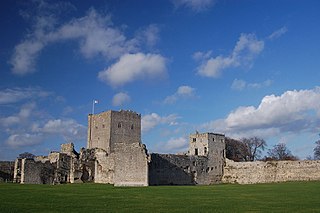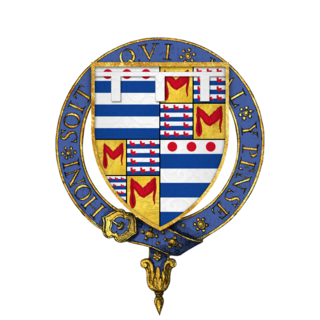Related Research Articles

Duke of Norfolk is a title in the peerage of England, and is the premier non-royal peerage. The seat of the Duke of Norfolk is Arundel Castle in Sussex, although the title refers to the county of Norfolk. The current duke is Edward Fitzalan-Howard, 18th Duke of Norfolk. The dukes have historically been Catholic, a state of affairs known as recusancy in England.

Earl Marshal is a hereditary royal officeholder and chivalric title under the sovereign of the United Kingdom used in England. He is the eighth of the great officers of State in the United Kingdom, ranking beneath the Lord High Constable of England and above the Lord High Admiral. The dukes of Norfolk have held the office since 1672.

Baron Mowbray is a title in the Peerage of England. It was created by writ for Roger de Mowbray in 1283. The title was united with the Barony of Segrave in 1368, when John Mowbray, 1st Earl of Nottingham and 5th Baron Mowbray, succeeded to that title. His successor was named Duke of Norfolk. With the childless death of Anne Mowbray, 8th Countess of Norfolk, in c.1481, the Barony went into abeyance between the Howard and Berkeley families, and both styled themselves Baron Mowbray and Seagrave.

Baron Segrave (Seagrave) is a title in the Peerage of England. It was created by writ in 1283 for Nicholas de Segrave, and the title is drawn from a village in Leicestershire now spelled Seagrave.

Baron Hastings is a title that has been created three times. The first creation was in the Peerage of England in 1290, and is extant. The second creation was in the Peerage of England in 1299, and became extinct on the death of the first holder in c. 1314. The third creation was in the Peerage of England in 1461, and has been in abeyance since 1960.

Earl of Effingham, in the County of Surrey, is a title in the Peerage of the United Kingdom, created in 1837 for Kenneth Howard, 11th Baron Howard of Effingham, named after the village of Effingham, Surrey, where heads of the family owned the manor.

Thomas of Brotherton, 1st Earl of Norfolk, was the fifth son of King Edward I of England (1239–1307), and the eldest child by his second wife, Margaret of France, the daughter of King Philip III of France. He was, therefore, a younger half-brother of King Edward II and a full brother of Edmund of Woodstock, 1st Earl of Kent. He occupied the office of Earl Marshal of England.
Margaret of Norfolk or Margaret of Brotherton, Duchess of Norfolk in her own right, was the daughter and eventual sole heir of Thomas of Brotherton, eldest son of King Edward I of England by his second marriage. In 1338, she succeeded to the earldom of Norfolk and the office of Earl Marshal. In 1397, she was created Duchess of Norfolk for life.

The House of Mowbray was an Anglo-Norman noble house, derived from Montbray in Normandy and founded by Roger de Mowbray, son of Nigel d'Aubigny.

Edward Howard, 9th Duke of Norfolk was an English peer and politician who was Earl Marshal from 1732 to 1777.

Sir Thomas Grey, of Heaton Castle in the parish of Norham, Northumberland, was one of the three conspirators in the failed Southampton Plot against King Henry V in 1415, for which he was executed.

Sir John GreyKG, English nobleman and soldier, of Ruthin, Denbighshire, Wales, Badmondisfield, Suffolk, Great Gaddesden, Hertfordshire, etc., second but eldest surviving son and heir apparent of Sir Reginald Grey, 3rd Baron Grey de Ruthyn by his 1st wife, Margaret Roos. He was also Captain of Gournay. He was Lord Lieutenant of Ireland in 1427-28, acting mainly through the Bishop of Meath as his Deputy.
John (II) de Mowbray, 3rd Baron Mowbray was the only son of John de Mowbray, 2nd Baron Mowbray, by his first wife, Aline de Brewes, daughter of William de Braose, 2nd Baron Braose. He was born in Hovingham, Yorkshire.

John (III) de Mowbray, 4th Baron Mowbray was an English peer. He was slain near Constantinople while en route to the Holy Land.

John (IV) de Mowbray, 1st Earl of Nottingham, 5th Baron Mowbray, 6th Baron Segrave, was an English peer.
Alice of Norfolk or Alice of Brotherton was an English noblewoman. She was the daughter of Thomas of Brotherton, and a granddaughter of King Edward I of England. She married Edward Montagu, 1st Baron Montagu.
Eleanor de Mowbray was the daughter of John de Mowbray, 4th Baron Mowbray, and Elizabeth de Segrave, 5th Baroness Segrave, daughter and heiress of John de Segrave, 4th Baron Segrave. She had two brothers and two sisters:
Edward Montagu, 1st Baron Montagu was an English knight and peer. He fought at the Battle of Crecy. His assaulted his first wife, Alice of Norfolk, who died as a result.

John Segrave, 4th Baron Segrave was an English peer and landowner in Leicestershire and Yorkshire. His family title of Baron Segrave is drawn from a village now spelled Seagrave, which uses a coat of arms imitated from that of the family.
Edward of Norfolk or Edward of Brotherton, was the only son of Thomas of Brotherton, and a grandson of King Edward I of England.
References
- 1 2 "Thomas Manny (son of Walter, 1st Baron Manny)". RoyaList Online. royalist.info. Archived from the original on March 3, 2016. Retrieved March 4, 2012.
{{cite web}}: CS1 maint: unfit URL (link) - ↑ Weever 1767, p. 216.
Bibliography
- Weever, John (1767). Antient funeral monuments, of Great-Britain, Ireland, and the islands adjacent. W. Tooke.
This article needs additional or more specific categories .(May 2023) |